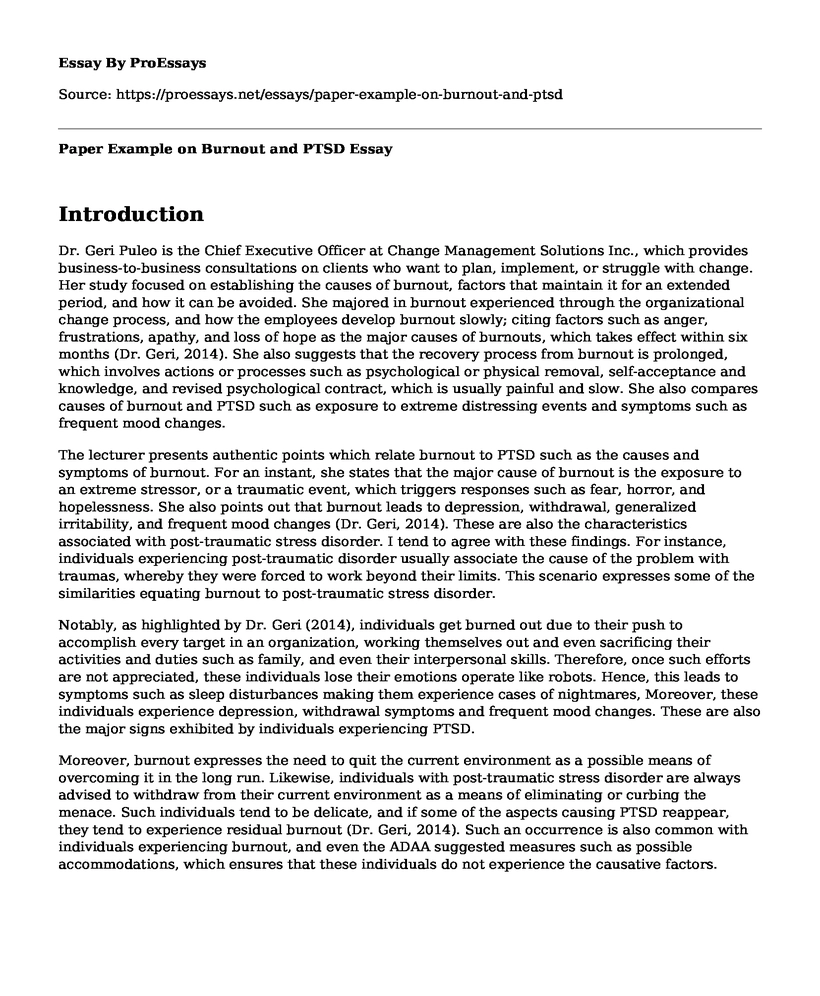Introduction
Dr. Geri Puleo is the Chief Executive Officer at Change Management Solutions Inc., which provides business-to-business consultations on clients who want to plan, implement, or struggle with change. Her study focused on establishing the causes of burnout, factors that maintain it for an extended period, and how it can be avoided. She majored in burnout experienced through the organizational change process, and how the employees develop burnout slowly; citing factors such as anger, frustrations, apathy, and loss of hope as the major causes of burnouts, which takes effect within six months (Dr. Geri, 2014). She also suggests that the recovery process from burnout is prolonged, which involves actions or processes such as psychological or physical removal, self-acceptance and knowledge, and revised psychological contract, which is usually painful and slow. She also compares causes of burnout and PTSD such as exposure to extreme distressing events and symptoms such as frequent mood changes.
The lecturer presents authentic points which relate burnout to PTSD such as the causes and symptoms of burnout. For an instant, she states that the major cause of burnout is the exposure to an extreme stressor, or a traumatic event, which triggers responses such as fear, horror, and hopelessness. She also points out that burnout leads to depression, withdrawal, generalized irritability, and frequent mood changes (Dr. Geri, 2014). These are also the characteristics associated with post-traumatic stress disorder. I tend to agree with these findings. For instance, individuals experiencing post-traumatic disorder usually associate the cause of the problem with traumas, whereby they were forced to work beyond their limits. This scenario expresses some of the similarities equating burnout to post-traumatic stress disorder.
Notably, as highlighted by Dr. Geri (2014), individuals get burned out due to their push to accomplish every target in an organization, working themselves out and even sacrificing their activities and duties such as family, and even their interpersonal skills. Therefore, once such efforts are not appreciated, these individuals lose their emotions operate like robots. Hence, this leads to symptoms such as sleep disturbances making them experience cases of nightmares, Moreover, these individuals experience depression, withdrawal symptoms and frequent mood changes. These are also the major signs exhibited by individuals experiencing PTSD.
Moreover, burnout expresses the need to quit the current environment as a possible means of overcoming it in the long run. Likewise, individuals with post-traumatic stress disorder are always advised to withdraw from their current environment as a means of eliminating or curbing the menace. Such individuals tend to be delicate, and if some of the aspects causing PTSD reappear, they tend to experience residual burnout (Dr. Geri, 2014). Such an occurrence is also common with individuals experiencing burnout, and even the ADAA suggested measures such as possible accommodations, which ensures that these individuals do not experience the causative factors.
Conclusion
However, I tend to differ with her conclusion that burnout must adopt a prolonged and complex recovery process. I believe that there are differences in the healing process from burnout as compared to individuals exposed to post-traumatic stress. For instance, if a person can successfully eliminate the causes or drivers of burnout, then he/she can successfully overcome burnout within a short period as compared to those with PTSD. PTSD is a psychological disorder, which vouches for progressive and coordinated actions for the affected persons to attain full recovery as compared to those experiencing burnouts. Hence, regardless of the similarities in the causative factors, the two conditions have different timelines for those affected to achieve revival.
References
Dr. Geri, P. (2014). Burnout and post-traumatic stress disorder: Dr. Geri Puleo at TEDxSetonHillUniversity. YouTube. Retrieved 1 May 2018, from https://www.youtube.com/watch?v=hFkI69zJzLI&feature=youtu.be.
Cite this page
Paper Example on Burnout and PTSD. (2022, May 16). Retrieved from https://proessays.net/essays/paper-example-on-burnout-and-ptsd
If you are the original author of this essay and no longer wish to have it published on the ProEssays website, please click below to request its removal:
- Hellen's Depression Case Analysis - Case Study Example
- Research Paper on Emotions: Anger vs. Contentment
- Reflection Paper on Intimacy
- Paper Example on Deviance Behavior of Lee Malvo and John Muhammad
- Essay Example on Aging and Dying: Dreaded Life Stages of Human Living
- Essay Example on Depression: Causes, Types, and Effects
- Stress and Resilience in the Work Place - Essay Sample







